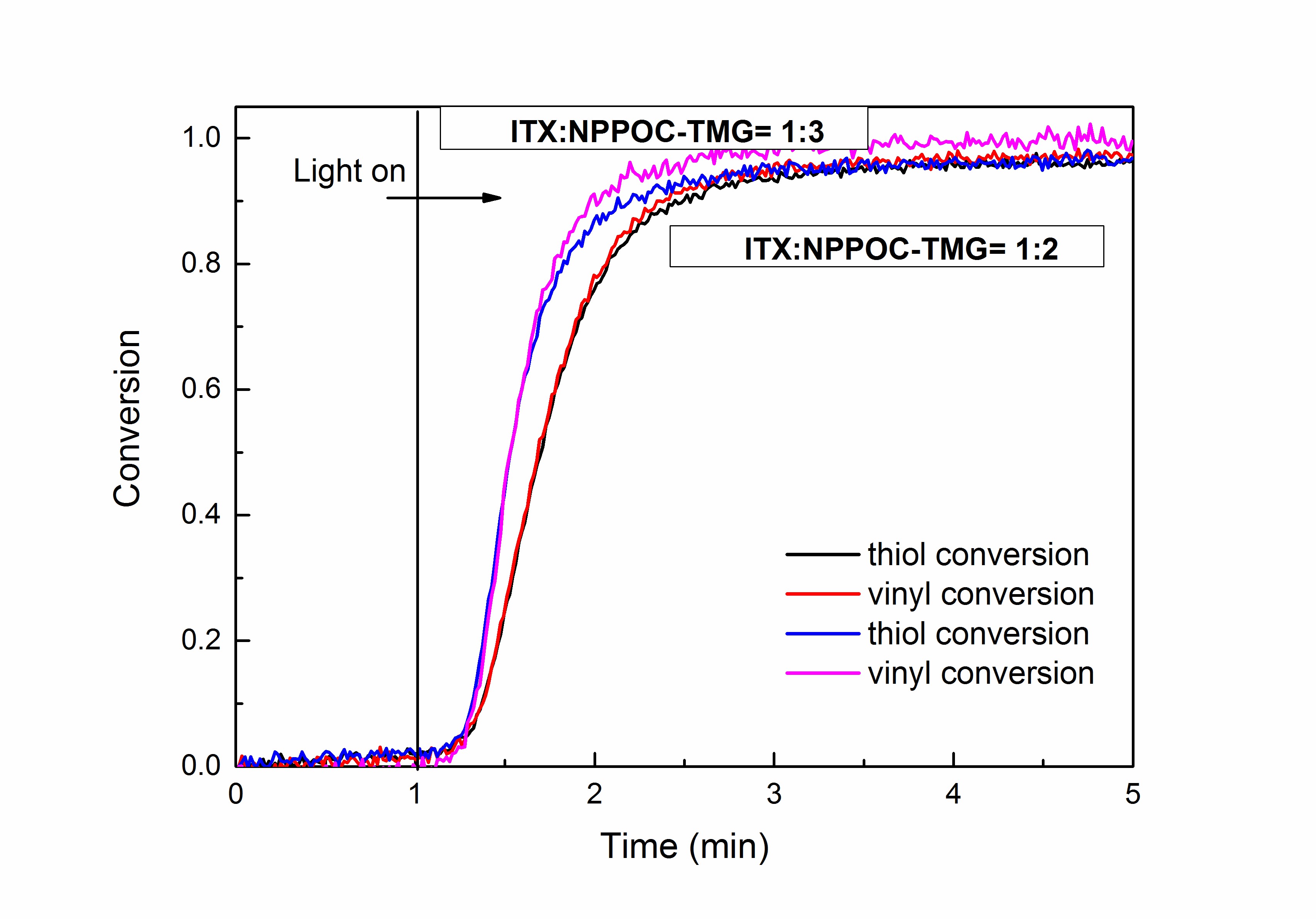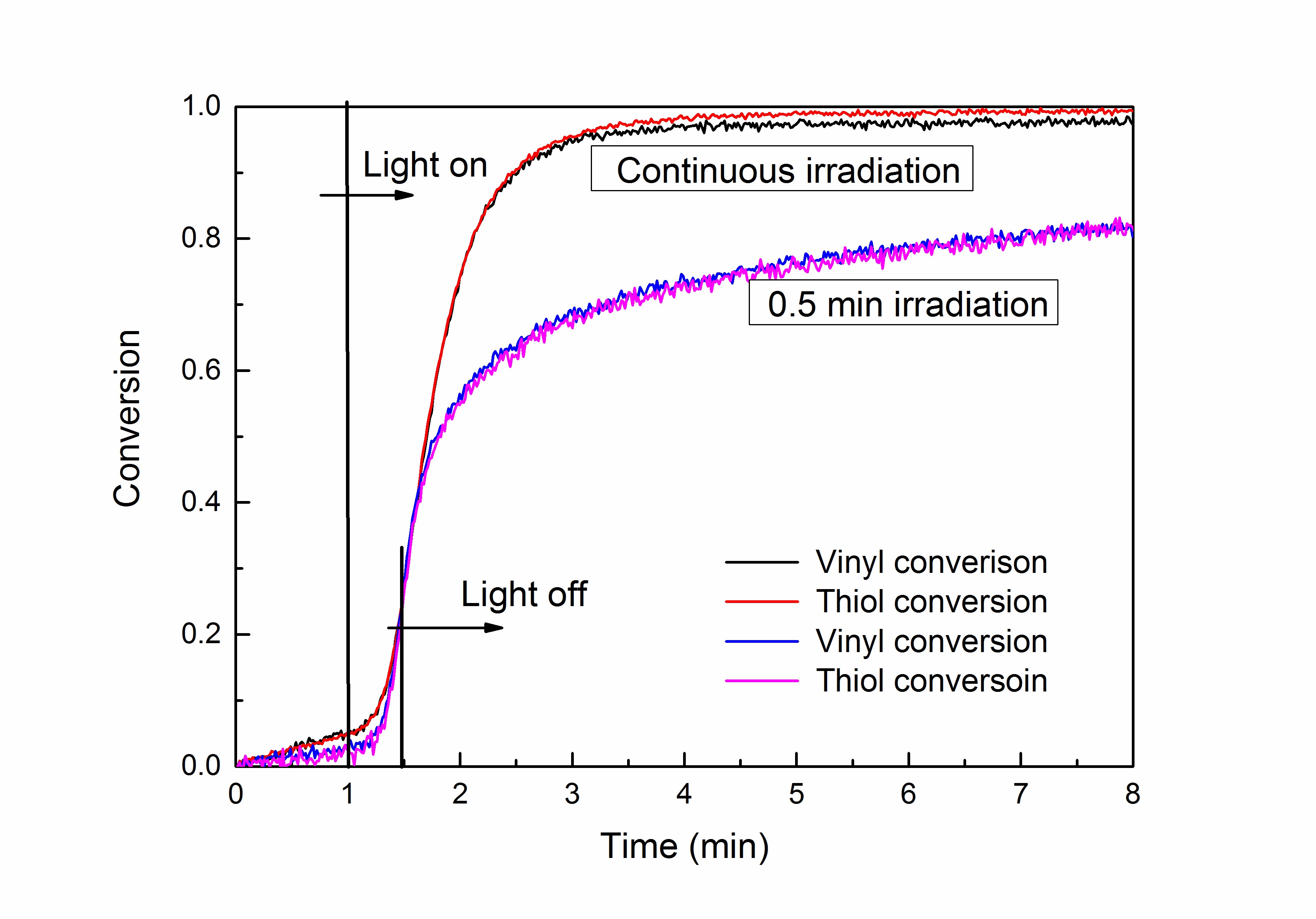IADR Abstract Archives
Efficient Photo-base Initiator System Design and Characterization for Thiol-Michael Addition Reactions in Dental Restoratives
Objectives: The objective of this work is to design a novel photo-base system which is sensitive to visible irradiation wavelengths as appropriate for dental curing. Compared to classical radical polymerization in dental applications, photoinitiated thiol-Michael polymerization initiated by photo-base catalysts provide unique benefits, such as stoichiometric reactions, delayed gel point, dark cure and deep cure. To study our photo-base systems, various experiments such as absorption measurements, quantum yield determination test and polymerization kinetics study of the photo-base systems were performed.
Methods: A series of thiol-Michael polymerizations were conducted initiated by visible (400-500 nm, 50mW/cm2) light. Phenol red was used to titrate and verify base generation. Different monothiols have been employed in model reactions to test the catalysts’ efficiency. Monomers used for the polymerization test: Divinyl sulfone (DVS) and pentaerythritol tetrakis(3-mercaptopropionate) (PETMP).Absorption and bleaching tests (UV-Vis test, using 400-500nm 50mW/cm2 irradiation), model monomer reactions (using NMR to check the final conversion, FT-IR to test the reaction time), and real-time polymerization kinetics (IR, monitoring C=C peak at 3085cm-1 and thiol peak at 2580cm-1) were all performed.
Results:
To achieve the goal of rapid, visible light initiated photoinduced thiol-Michael polymerization, novel visible photo-base generators coumarin-TMG and MNPPOC-TMG were designed and visible light sensitization of NPPOC-TMG was also explored. For the majority of our initiator systems, we are able to achieve over 90% conversion rapidly in the thiol-Michael polymerizations upon visible light exposure. By using the sensitization method, the fastest average polymerization rate of the thiol was found to be 0.12 M/s in the thiol-Michael reaction.
Conclusions: Different photo-base catalysts systems which are sensitive to appropriate wavelengths (especially visible light) were designed and studied. These photo-base systems exhibit excellent catalytic activities in initiating thiol-Michael polymerizations which could be used as novel dental resin or implemented in other applications, for example, coatings and biomaterials etc.
Methods: A series of thiol-Michael polymerizations were conducted initiated by visible (400-500 nm, 50mW/cm2) light. Phenol red was used to titrate and verify base generation. Different monothiols have been employed in model reactions to test the catalysts’ efficiency. Monomers used for the polymerization test: Divinyl sulfone (DVS) and pentaerythritol tetrakis(3-mercaptopropionate) (PETMP).Absorption and bleaching tests (UV-Vis test, using 400-500nm 50mW/cm2 irradiation), model monomer reactions (using NMR to check the final conversion, FT-IR to test the reaction time), and real-time polymerization kinetics (IR, monitoring C=C peak at 3085cm-1 and thiol peak at 2580cm-1) were all performed.
Results:
To achieve the goal of rapid, visible light initiated photoinduced thiol-Michael polymerization, novel visible photo-base generators coumarin-TMG and MNPPOC-TMG were designed and visible light sensitization of NPPOC-TMG was also explored. For the majority of our initiator systems, we are able to achieve over 90% conversion rapidly in the thiol-Michael polymerizations upon visible light exposure. By using the sensitization method, the fastest average polymerization rate of the thiol was found to be 0.12 M/s in the thiol-Michael reaction.
Conclusions: Different photo-base catalysts systems which are sensitive to appropriate wavelengths (especially visible light) were designed and studied. These photo-base systems exhibit excellent catalytic activities in initiating thiol-Michael polymerizations which could be used as novel dental resin or implemented in other applications, for example, coatings and biomaterials etc.


